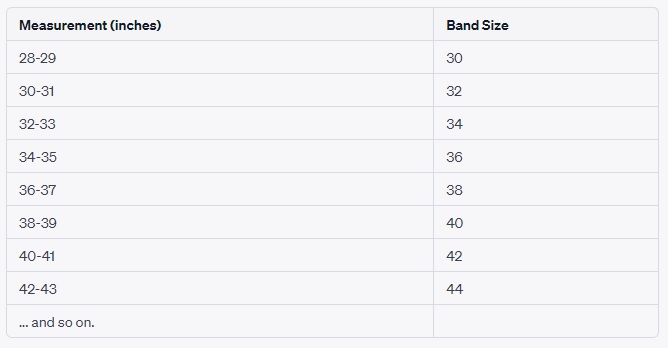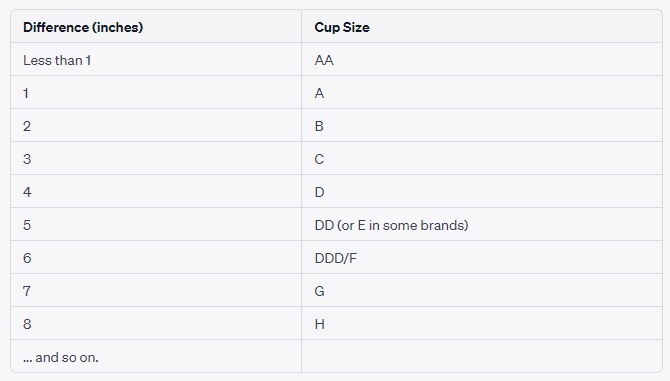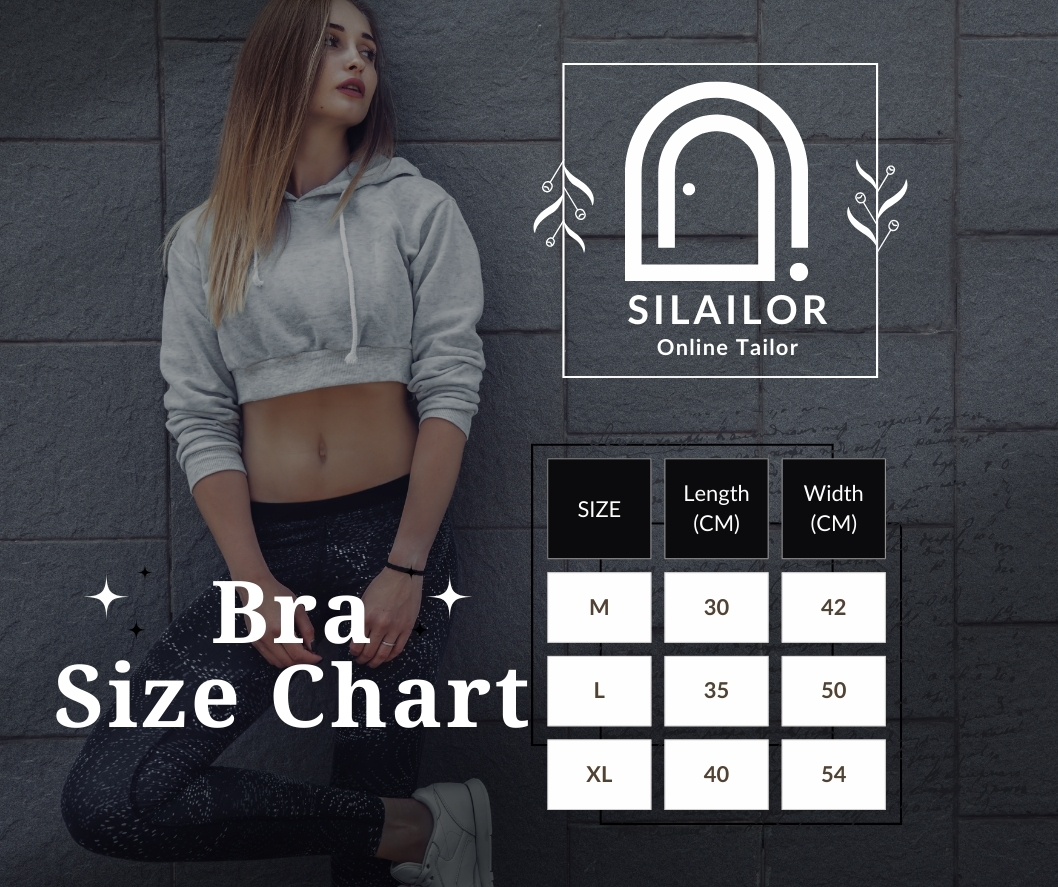Finding the perfect bra size is a journey often paved with confusion and misconceptions. Central to this journey is the “Bra Size Chart” – a vital tool designed to guide women towards their ideal fit.
A bra size chart not only offers a systematic way of pairing band and cup sizes but also serves as a universal translator among different brands and countries, each with its sizing conventions. By understanding and utilizing these charts, women can enhance comfort, boost confidence, and ensure that their undergarments provide the optimal support and aesthetic appeal.
As each body is unique, the cup bra size chart acts as a starting point, leading to a world where lingerie complements and celebrates every contour and curve.
What Is Bra Size?
Bra size refers to a combination of numerical and alphabetical measurements that designate the size of a bra. It gives an indication of the size and fit of a bra, aiming to provide support, comfort, and a desired aesthetic appearance. The bra size is typically composed of two main components:
- Band Size (Number): This is the circumference around the torso, directly under the bust. It provides the primary support for the breasts. The band size is usually denoted by a number, such as 32, 34, 36, and so on.
- Cup Size (Letter): This represents the volume or capacity of the bra’s cups. It’s calculated by the difference between the measurement of the bust at its fullest point and the band size. The cup size is usually indicated by a letter or series of letters, such as A, B, C, D, DD, and so on.
So, when you see a bra size written as “34C”, for instance:
- “34” refers to the band size.
- “C” denotes the cup size.
Combined, they give an overall indication of the bra’s size.
It’s important to note that bra sizing can vary based on regions and brands. For example, the UK, US, and European countries might have slightly different systems or specifications. Because of these potential variations and the nuances of individual fit, many women find it helpful to get professionally measured or to try on multiple sizes to find the most comfortable and supportive fit.
How to Measure Bra Size Chart
Certainly! Finding the right bra size is essential for comfort and proper support. Here’s a step-by-step guide on how to measure bra size:
STEP 1: MEASURE YOUR BAND SIZE
- Materials: You’ll need a soft measuring tape. If you don’t have one, use a string or cord and measure it against a ruler later.
- Procedure:
- Stand upright without wearing a bra or wear a non-padded bra.
- Wrap the measuring tape around your torso directly under your bust, where a bra band would sit.
- Make sure the tape is snug and level around your body.
- Take this measurement. If it’s an odd number, round up to the nearest even number. This is your band size.
STEP 2: MEASURE YOUR BUST SIZE
- Wrap the measuring tape loosely around the fullest part of your bust (typically at the nipple level).
- Ensure the tape isn’t too tight or causing compression, but is still level across your back.
- Record this measurement.
STEP 3: FIND YOUR CUP SIZE
- Subtract your band measurement from your bust measurement.
- Use the difference to find your cup size:
- 1” = A
- 2” = B
- 3” = C
- 4” = D … (and so on, noting that sizing can differ by brand and country)
- Or you can simply check their “bra measurement chart”.

 STEP 4: PUT IT ALL TOGETHER
STEP 4: PUT IT ALL TOGETHER
- Combine your band size with your cup size. For instance, if your band size is 34 and you’ve determined you’re a C cup, then your bra size is 34C.
STEP 5: DON’T GET ATTACHED
- Even if you get a particular size, don’t get attached to it. Brands, styles, and even different models within a brand can vary in sizing.
- It’s essential to try different sizes to see what feels the most comfortable and offers the best support and shape.
STEP 6: REPEAT, OFTEN
- Our bodies change due to various factors: weight fluctuations, pregnancies, aging, and more.
- Make it a practice to measure yourself at least once a year or when you feel that your current bras aren’t fitting as they should.
Lastly, remember that comfort is key. Even if you measure a certain size, you should always wear what feels best for you. And if you can, getting a professional fitting can help provide insights into the best bra styles and sizes for your shape.
Detailed Bra Size Chart India
In India, the bra sizing system is similar to the UK system, but there can be variations based on brands and specific body types of Indian women. It combines band size (a number) with cup size (a letter).
Here’s a basic guideline for measuring and determining bra size:
1. Band Size (in centimeters) To find out your band size:
- Use a measuring tape.
- Measure around your rib cage directly under the bust. Ensure the tape is snug.
- If you get an odd number, round up to the nearest even number.
- This gives your band size in centimeters.
2. Cup Size To determine your cup size:
- Measure loosely around the fullest part of your bust.
- Subtract your underbust measurement from your bust measurement.
- Use the difference to determine the cup size based on the chart below:
Bra Size Chart CM (for Indian body types):
Under Bust (cm) | Bust (cm) - Cup Size | Bra Size |
68-72 | 82-84 (A), 84-86 (B) etc. | 30A, 30B etc. |
73-77 | 87-89 (A), 89-91 (B) etc. | 32A, 32B etc. |
78-82 | 92-94 (A), 94-96 (B) etc. | 34A, 34B etc. |
83-87 | 97-99 (A), 99-101 (B) etc. | 36A, 36B etc. |
88-92 | 102-104 (A), 104-106 (B) etc. | 38A, 38B etc. |
... | ... | ... |
Type Of Bras
Bras come in a wide variety of styles, each designed to serve specific needs and preferences. Here’s a list of common types of bras:
- T-shirt Bra: Has smooth, molded cups that provide a seamless look under fitted tops.
- Push-Up Bra: Push up bra features padding at the bottom of the cups to lift the breasts, enhancing cleavage.
- Padded Bra: Comes with padded cups to add volume to the breasts.
- Sports Bra: Provides support during physical activity to reduce breast movement. They come in low, medium, and high-impact designs based on the intensity of the activity.
- Balconette Bra: A demi-style bra that offers less coverage than a full-cup bra, providing a horizontal line along the bust.
- Bralette: A soft, non-wired bra, often made of lace or other decorative fabric. It provides light support and is often worn for comfort or as a fashion statement.
- Strapless Bra: Designed without shoulder straps, ideal for wearing under strapless dresses or tops.
- Convertible/Multiway Bra: Comes with detachable straps that can be rearranged in different ways (like halter, one-shoulder, crisscross) to wear under various outfits.
- Full-Coverage Bra: Provides complete coverage of the breasts, suitable for women who want more support or have fuller busts.
- Plunge Bra: Designed with a deep ‘V’ neckline, suitable for low-cut tops or dresses.
- Wireless Bra: Lacks an underwire, offering a more relaxed fit. Ideal for those who find wired bras uncomfortable.
- Maternity Bra: Designed for pregnant women, these bras are expandable and adjust to the changing breast size during pregnancy.
- Nursing Bra: Designed for breastfeeding mothers, it comes with flaps or panels that can be easily opened to feed the baby without taking off the bra.
- Minimizer Bra: Intended for women with larger busts, this bra redistributes breast tissue to reduce the projection of the breasts.
- Mastectomy Bra: Designed for women who have undergone mastectomy surgery. These bras have pockets to hold breast prostheses.
- Adhesive Bra: These are stick-on bras that adhere to the breasts, providing support without the need for back or shoulder straps. Suitable for backless or sheer outfits.
- Peephole Bra: A more risqué style, this bra features holes or cut-outs in the cups.
- Longline Bra: Extends down to the waist or hips, offering more support and sometimes used as bridal lingerie.
- Cage Bra: Fashion-forward with multiple straps on the back or front, creating a “cage” effect. Often worn as outerwear or to be visible under clothes for a style statement.
- Sheer Bra: Made with transparent or semi-transparent material, usually lace or mesh.
FAQs
What are sister sizes?
Sister sizes are bra sizes that have the same cup volume but different band sizes and cup letters. For example, if you wear a 34C but find the band too tight, you might find a 36B to be a more comfortable fit. Conversely, if the band is too loose, you might prefer a 32D. The cup volume remains the same in these sizes.
What To Do When Correct Bra Size Doesn’t Fit? Know Sisterhood of Cups.
If the bra size that you have measured doesn’t fit, it might be due to differences in brand sizing, bra styles, or your unique breast shape. Sister sizes can help in this situation. Sister sizes are alternative sizes where the cup volume stays the same even though the band size and cup letter changes. For example, the sister sizes for 34C are 32D and 36B. Trying a sister size may help you find a better fit.
Which bra size is bigger A or B or C?
Bra cup sizes generally increase in volume as you move up the alphabet. So in the typical sizing progression:
- A is smaller than B.
- B is smaller than C.
What is ABCD in bra size?
The letters like A, B, C, D, etc., in bra sizing represent the cup size. The cup size is determined by the difference between the measurement of the bust at its fullest point and the underbust measurement. The greater the difference, the larger the cup size, with A being the smallest and the size increasing as you move up the alphabet.
What is the difference between cup size & bra size?
Aspect | Cup Size | Bra Size |
Definition | Represents the volume of the breasts. | A combination of the band size (number) and the cup size (letter). |
Representation | Denoted by letters (e.g., A, B, C, D, etc.). | Combination of a number and a letter (e.g., 32B, 34C, 36D, etc.). |
Measurement Base | Determined by the difference between the bust and underbust measurements. | Derived from both the underbust measurement (band size) and the difference between bust and underbust (cup size). |
Function | Indicates how deep or voluminous the bra’s cups need to be. | Provides an overall fit, encompassing both the band’s snugness around the torso and the cup’s volume. |
How to find the right bra for your breast shape?
Different breast shapes may require different styles of bras. Here’s a general guide:
- Round: Most bra styles will fit.
- Teardrop: A plunge or push-up bra can be flattering.
- Bell Shape: Full-coverage or balconette styles may offer better support.
- Asymmetric: A bra with padding that can be adjusted or removed on one side can help.
- Slender: A push-up or balconette bra can enhance the shape.
- East-West: T-shirt or push-up bras can help to draw the breasts inwards.


